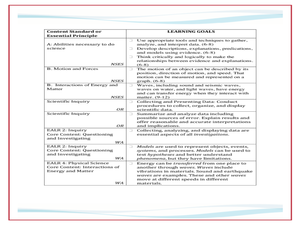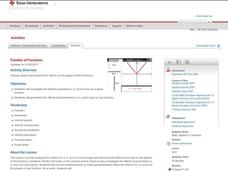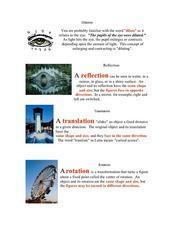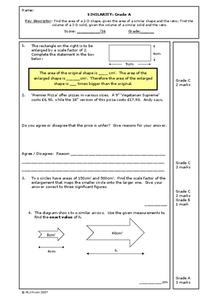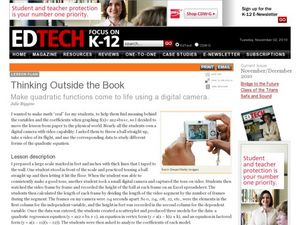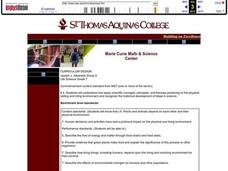Curated OER
Conditions at Sea Introductory Activity, Making Waves
Young scholars explore waves and wind. In this physical and earth science wave lesson, students participate in a wave making activity with an aquarium and a hair dryer. Young scholars complete a data chart recording wave height and...
Curated OER
Families of Functions
Learners use sliders to change the parameters of functions and examine how shifting parameters affects a graph. They identify the parameters of functions, find vertical and horizontal stretches, then calculate the scale factor and other...
Curated OER
Dilation
Tenth graders identidy and define various geometry terms, Students create exact replicas of a shape that is either smaller or larger than the original shape. Students prove that their entire shapes are larger or smaller in the same...
PHET
Planet Designer: What’s Trending Hot?
Excite scholars to design their own planet in this first of five lessons. The lesson starts with a pre-activity assessment, a complete lesson plan that is easy to implement, and a post-activity assessment that would look great...
National Wildlife Federation
Ghost Town
Around 93 percent of the reefs on Australia's Great Barrier Reef have been bleached, and almost one quarter of them are now dead. Scholars research the sea temperatures, especially around the areas with coral reefs, to make connections...
Curated OER
Take Another Look
Seventh graders analyze different types of graphs and answer questions related to each. In this math lesson, 7th graders organize a given diagram to make it easier to interpret. They discuss why they made such changes.
Curated OER
Enlargement Worksheet
In this math worksheet, students find the centre of enlargement, scale factor and label the images. The images give a perspective of how the size scale changes.
Noyce Foundation
Photographs
Scaling needs to be picture perfect. Pupils use proportional reasoning to find the missing dimension of a photo. Class members determine the sizes of paper needed for two configurations of pictures in the short assessment task.
Curated OER
Let the Matrix Do It
Young scholars create a matrix of the vertices of a triangle and produce new matrices that dilate, translate, rotate, and reflect the original triangle. After multiplying each matrix by a new scale factor, they graph the new matrix and...
Curated OER
Astronomical Scales
Students describe the different units of measurement. In this space science lesson plan, students calculate astronomical distances using a scale. They explain the significance of using scientific notation in expressing very small or...
Curated OER
Scale Drawing
Learners use ratio and proportions to solve problems. In this geometry lesson, students apply ratio and proportions to real life scenarios.
Curated OER
Similarity
In this similarity worksheet, 9th graders solve and complete 6 different types of problems. First, they complete the statement in the box shown. Then, students determine whether they agree or disagree with the statement and given...
Curated OER
Simplifying Ratios
In this simplifying ratios worksheet, 10th graders solve and complete 24 various types of problems. First, they complete each ratio and reduce when necessary. Then, students find the length and width of each rectangle described. They...
Curated OER
The Language of Science
In this language of science activity, students use the list provided to guess the meaning of each of the list. Students apply root words, prefixes, and suffixes to gain meaning of other science words.
Curated OER
Math Skills: Conversions
In this conversions worksheet, students use metric unit conversions to solve fifteen word problems that involve converting from one unit to another.
Curated OER
Six Exercise Sets on Transformations
Middle and high schoolers solve fifteen problems from six exercise sets covering transformations, reflections, rotations, and enlargements. The solutions are provided.
Curated OER
Making Summer School Less of a Drag
Teaching summer school is the perfect opportunity for experimenting and expanding your classroom repertoire.
EngageNY
An Appearance of Complex Numbers 2
Help the class visualize operations with complex numbers with a instructional activity that formally introduces complex numbers and reviews the visualization of complex numbers on the complex plane. The fifth installment of a...
Chicago Botanic Garden
What Can Tree Rings Tell Us About Climate?
Tree rings are slightly thicker on the south side of the tree because it receives more sunlight. Part two in a series of five lessons helps learners analyze tree rings to determine the environmental conditions that caused size...
Chymist
Visualizing pH
Why are acids and bases important in our daily lives? Lead the class in answering this question, among others, as they experiment with pH paper and classify where various substances belong on the pH scale. They also taste common acids...
Curated OER
Mass vs. Weight
Why do you weigh more in space? Each individual in your class explores this question and others as they determine the mass and weight of different objects using two types of scales. They perform conversions and discuss their...
Curated OER
Thinking Outside the Box
Now this lesson sounds fun! Students throw a ball, film it as it soars through the air, and use a spreadsheet to collect data. A scatterplot is created to produce a quadratic regression equation, an equation in vertex form, and an...
Curated OER
Plants and Animals
Seventh graders discover the interconnectedness of plants and animals in ecosystems. In groups, they create a food web and discuss the problems when one link of the chain is broken. To end the lesson plan, they set up a balanced...
Forest Foundation
Fire Investigation and Experimentation
Assess the probability of a wildfire with several lessons about fire danger ratings and risk factors. After experimenting with fuel moisture, learners explore the various elements that could contribute to a wildfire, such as wind...
